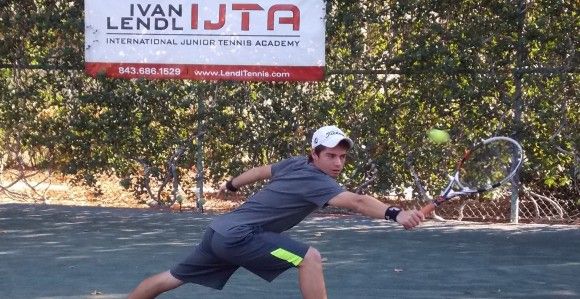Injuries and Comebacks: The Mental Perspective – By Matt Cuccaro
By Matt Cuccaro, Ed.M.
Tennis can be a brutally, physical game. The lower body is constantly pounding on hard surfaces. A significant amount of torque and change of direction is required to exhibit maximum speed and power. The repeated impact placed on elbows and wrists with every serve, volley and groundstroke can be taxing on the body. At some point in every player’s career, there will be an injury. When active lifestyles turn sedentary, there can be more than just a physical shock to the system. The rehab process becomes just as much of a mental hurdle as a physical one. Here are three ideas to assist along the physical and mental road to recovery:
1. Injury recovery is your new sport (and the doctor is your new coach). Practicing serves may be replaced by icing on the couch. Endurance training may be supplanted by light stretching or work with an exercise band. Consider the rehab process to be your new training regimen and replace effort on the court toward the recovery process off the court.
2. An injured body does not have to mean an injured mind. Although your body might not be ready to get back on the court, your mind likely is. Stay in the game mentally. Find a quiet spot and continue replaying your action plan upon return to the court. Seeing and feeling aggressive strokes with solid execution in your mind’s eye will assist the transition when physicians clear you to play.
3. Maintain perspective and redefine success throughout the rehab process. Would you prefer to be out of action for two weeks or two months? Patience throughout the recovery process may actually get you back on the court quicker than pushing an injury to the point where it becomes a chronic problem. Realize that a fully recovered body will perform better, longer and stronger than one that is still fighting to heal.
The beloved Andy Murray had to face the hardship of withdrawing from the French Open before tasting victory only four weeks later at Wimbledon. Knowing when to stop and when to re-start can be a difficult and daunting task for athletes who are used to pushing themselves to the limit. Injuries and recovering from them can be seen as another opportunity to stretch one’s personal limit on pain, patience and perseverance.
About Matt Cuccaro
Matt Cuccaro has nearly a decade of experience working with athletes, coaches and administrators on the mental aspects of high performance. He serves as Director of Mental Training for Junior Sports Corporation (Hank Haney International Junior Golf Academy and Ivan Lendl International Junior Tennis Academy) on Hilton Head Island, S.C. In addition to his work with juniors, his clients include professional and amateur athletes around the world in a number of sports and domains. Follow him on Twitter: @MentalCoachMatt.
For more information on Ivan Lendl IJTA: www.LendlTennis.com/info, 888.936.5327.
Topics: Andy Murray, Ivan Lendl, Ivan Lendl IJTA, Matt Cuccaro, tennis injuries, Tennis News, tennis tips


10sBalls Top Stories
- Deneme Bonusu Kampanyaları ile Yatırımsız Kazanç Sağlama
- 2024’ün En İyi Bonus Kampanyaları Hangileri?
- Hoşgeldin Bonusu Almanın Avantajları
- Güncel Deneme Bonusları: Hangi Sitelerde Mevcut?
- 2024 Yılında Deneme Bonusları Veren Sitelerin Özellikleri
- Deneme Bonusu İle Eğlenceli Slot Oyunları
- Efesbet Lisansı: Kayıtlı Olduğu Kurumlar
- Почему Отказывают В Выплате Dragon Money?
- Драгон Мани Играть На Деньги! Мобильная Версия Доступна Уже!
- Казино Комета (Kometa) официальный сайт, войти через рабочее зеркало
- Онлайн казино Комета (Kometa): лучший выбор для игроков
- Зеркало Kometa Casino | Рабочее Зеркало для Входа в Комета Казино 2024
- Казино Банда Зеркало
- Казино Банда (Banda) Официальный Сайт, Войти Через Рабочее Зеркало
- Банда Казино Мобильная Версия Официальный Сайт Banda Casino
In Case You Missed It

Официальный Сайт Банда Казино Casino Banda: Регистрация, Вход И Бонусы ️ Играть Онлайн На Официальном Сайте Banda Casino
Официальный сайт Banda Casino регистрация вход
Banda Casino Зеркало – Рабочие Зеркало На Сегодня Банда Казино
Актуальные рабочие зеркала казино Банда на
Banda Casino Зеркало – Рабочие Зеркало На Сегодня Банда Казино
Обновленное зеркало Банда казино на сегодня
Как Войти В Онлайн Казино Банда?
Как начать играть в онлайн казино





 Injuries and Comebacks: The Mental Perspective - By Matt Cuccaro |
Injuries and Comebacks: The Mental Perspective - By Matt Cuccaro |
RT @MentalCoachMatt: The mental side of injury recovery http://t.co/0YS9m9gdww @IvanLendlIJTA
RT @MentalCoachMatt: The mental side of injury recovery http://t.co/Tr3vuoIy5n @IvanLendlIJTA
RT @MentalCoachMatt: The mental side of injury recovery http://t.co/0YS9m9gdww @IvanLendlIJTA